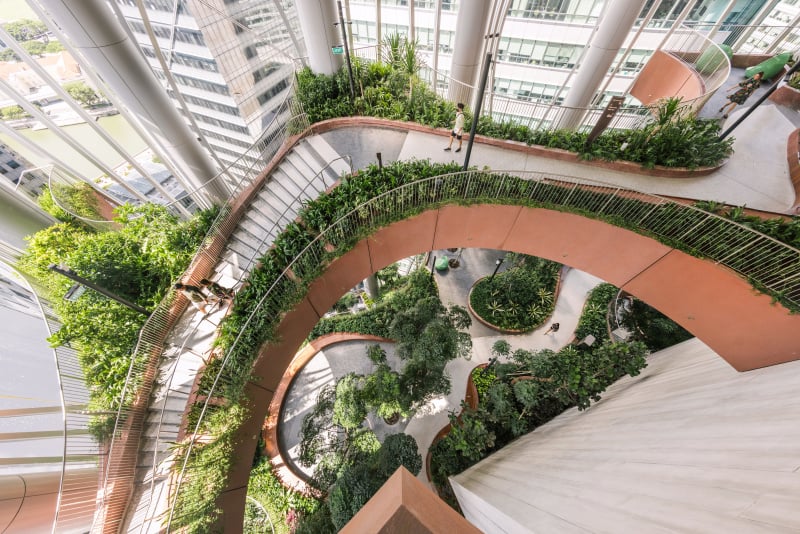
A biophilic skyscraper with over eighty thousand plants and trees spread out over 8,361 square meters has just opened its doors in Singapore. CapitaSpring, located in Singapore’s financial district, took four years to build and is now one of the tallest towers in the city’s skyline.
The biophilic tower is also part of Singapore’s city-wide tree-planting programs that has led urban planners to construct what they call a garden city. This was the goal of former Prime Minister Lee Kuan Yew, who coined the term in the 1960s.
CapitaSpring: a 51-story biophilic skyscraper
CapitaSpring is a 280 square meter tall biophilic skyscraper set smack in the heart of the city. The project is the brain child of Bjarke Ingels Group (BIG), which aimed to create a distinctive urban oasis that mixed all elements of daily life.
“Due to the unique character of Singapore’s urbanism—both extremely dense and green— we decided to make the design a vertical exploration of tropical urbanism,” Bjarke Ingels, a founding partner of the firm, stated.
“CapitaSpring is like a vision of a future in which city and countryside, culture and nature, can coexist and urban landscapes can expand unrestricted into the vertical dimension,” Ingels maintained.
CapitaSpring is not merely an office building, however. Rather, its fifty-one stories include space for working, living, and playing. The twenty-nine floors at the very top are reserved for offices and retail space. The residential area on the first eight floors offers amenities, such as a swimming pool, jacuzzi, gym, running track, a residents lounge and social kitchen, and outdoor barbecue pits.
On the inside is a thirty-four square meter open-air garden that covers four stories. It links the residential and business areas. The plants chosen are meant to duplicate those found in a tropical rainforest. The open spaces are used for work, relaxation, and various events.
There is also a rooftop garden with more than one hundred and fifty flowers, herbs, fruits, and vegetables. An urban farmer who tended the garden said that it produced seventy to one hundred kilograms of produce each month. That is more than enough bounty to serve as part of the cuisine of the rooftop restaurant.
What is biophilia?
The word biophilia comes from the Greek idea of ‘philia,’ which means friendship, affectionate regard or love. Thus, biophilia literally means a love of life. The term was first used in 1964 by psychologist Erich Fromm to describe what he called “the passionate love of life and all that is alive.” Then, in 1984, the American biologist Edward O. Wilson wrote a book of the same title. In his book, Wilson defined biophilia as “the urge to affiliate with other forms of life.”
Biophilic design is urban planning that connects buildings or cities to the natural environment. Urban planners do so by incorporating nature into urban environments. It is not a new idea but dates back to ancient times.

The Hanging Gardens of Babylon were perhaps the first example of biophilic design. In Hellenic culture, they are considered one of the Seven Wonders of the Ancient World. The human need to interact daily with nature was therefore just as important then, it seems, as it is nowadays. In fact, more than ninety percent of people imagine themselves in nature when thinking of a relaxing place, researchers have found.
Biophilia has thus become more and more important in the fields of both science and architectural design. This is mainly because being in nature appears to aid in the management of stress. It also improves productivity and enhances learning. Furthermore, there is a direct correlation between biophilic work spaces and faster recovery from illness.
Why is it important?
Biophilic designs attempt to create structures that promote general well-being. Its key elements include views of nature, the use of natural materials, natural features—such as indoor plants—water features, and maximized daylight.
This concept has become increasingly popular today, as it seems to have a marked impact on work productivity. Dr. Craig Knight of Exeter University conducted a study on the correlation between ‘drab’ office work spaces and employee motivation. According to Knight, people were fifteen percent more productive if they were able to have plants in the office.
“If you put an ant into a ‘lean’ jam jar, or a gorilla in a zoo into a ‘lean’ cage—they’re miserable beasts,” he said. “People in lean offices are no different.”
During the course of his research, Knight found that plants brought into office spaces improved employee memory retention and, thus, performance among others aspects.
“What was important was that everybody could see a plant from their desk,” he stated. “If you are working in an environment where there’s something to get you psychologically engaged you are happier and you work better.”
Athens itself is poised to get its first true skyscraper within the next three to four years. The Hellinikon Project, one of the largest in Greek history, broke ground this summer. Its coastal park is expected to be bigger than both Hyde Park in London and Central Park in New York City.
See all the latest news from Greece and the world at Greekreporter.com. Contact our newsroom to report an update or send your story, photos and videos. Follow GR on Google News and subscribe here to our daily email!



